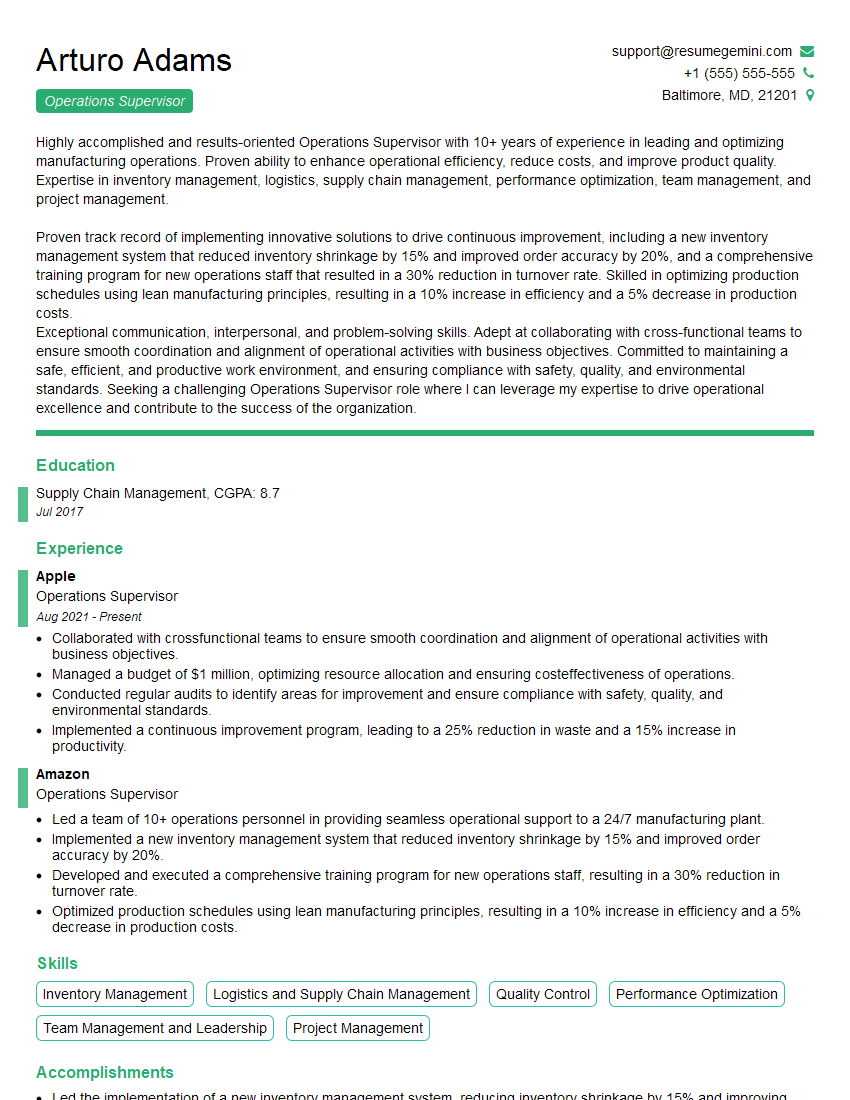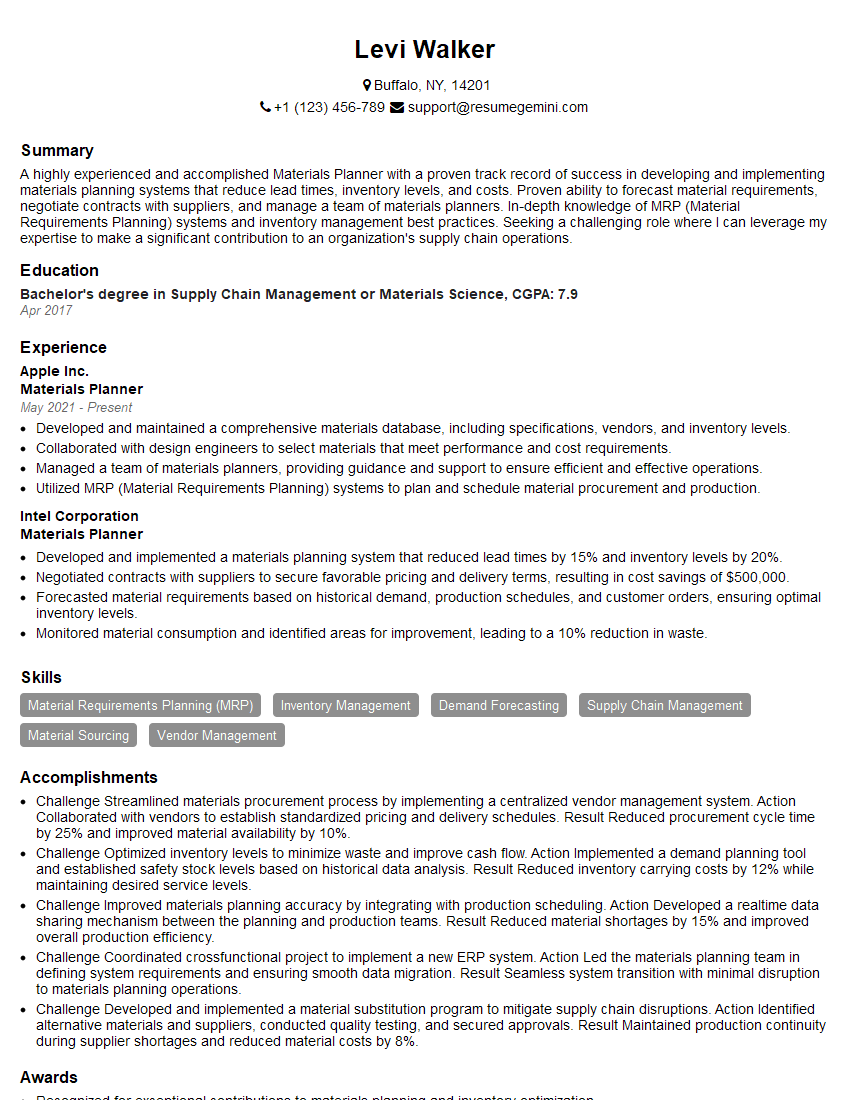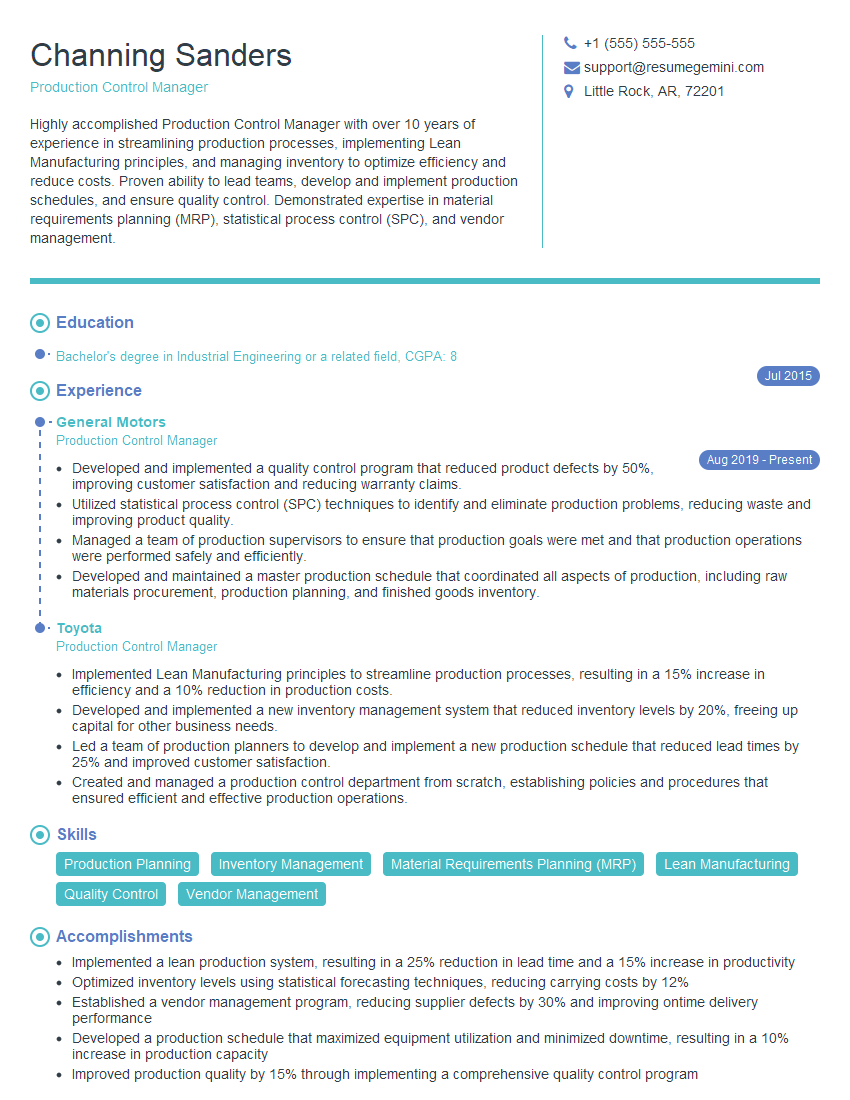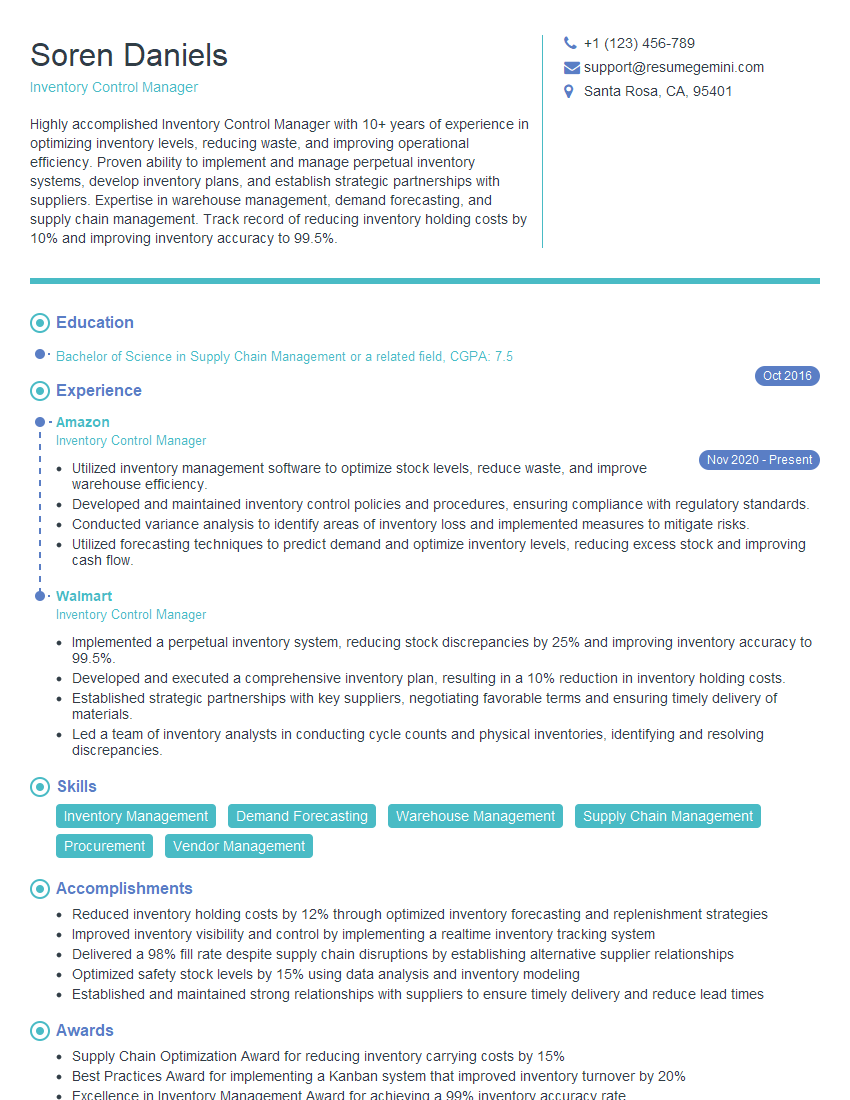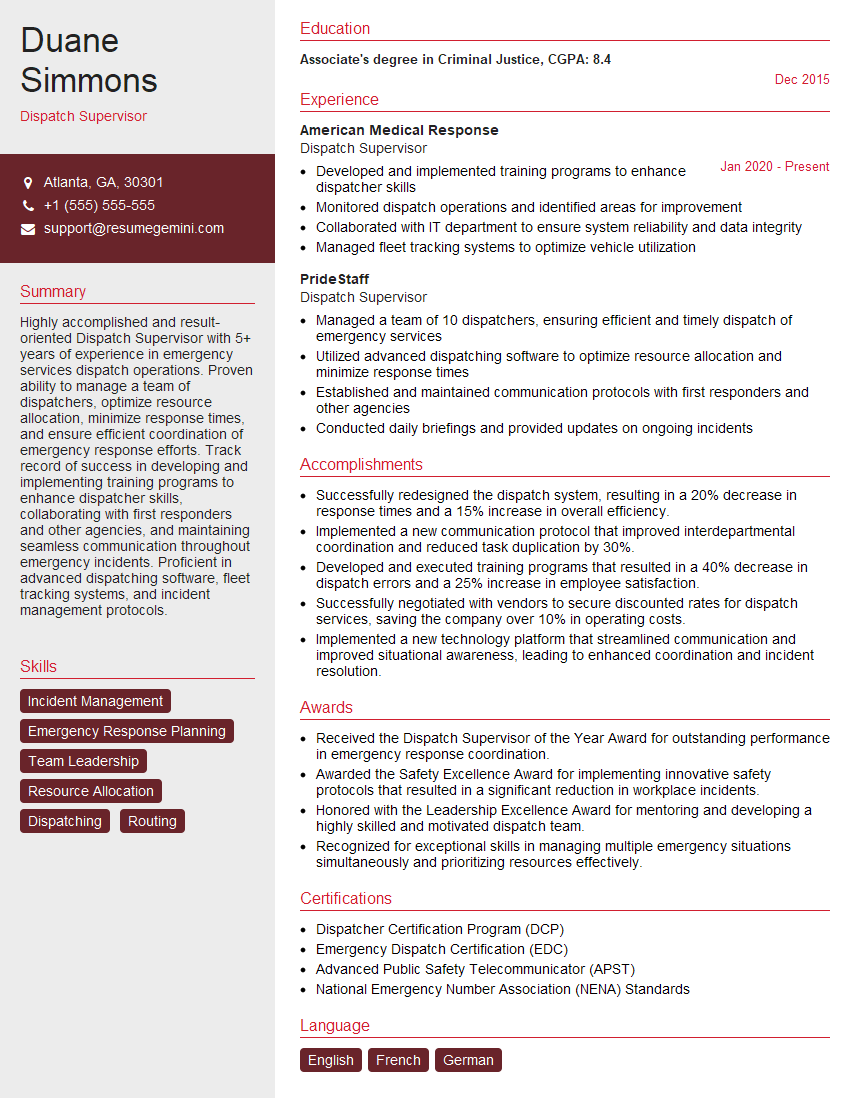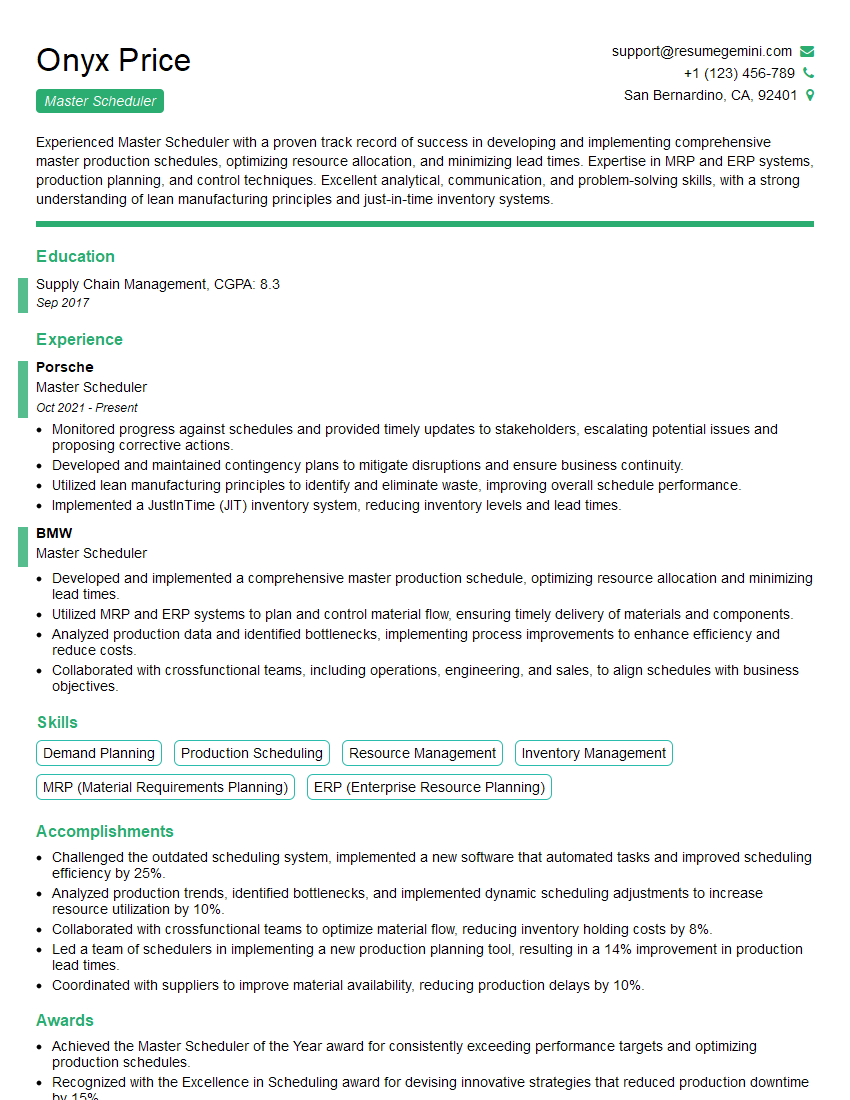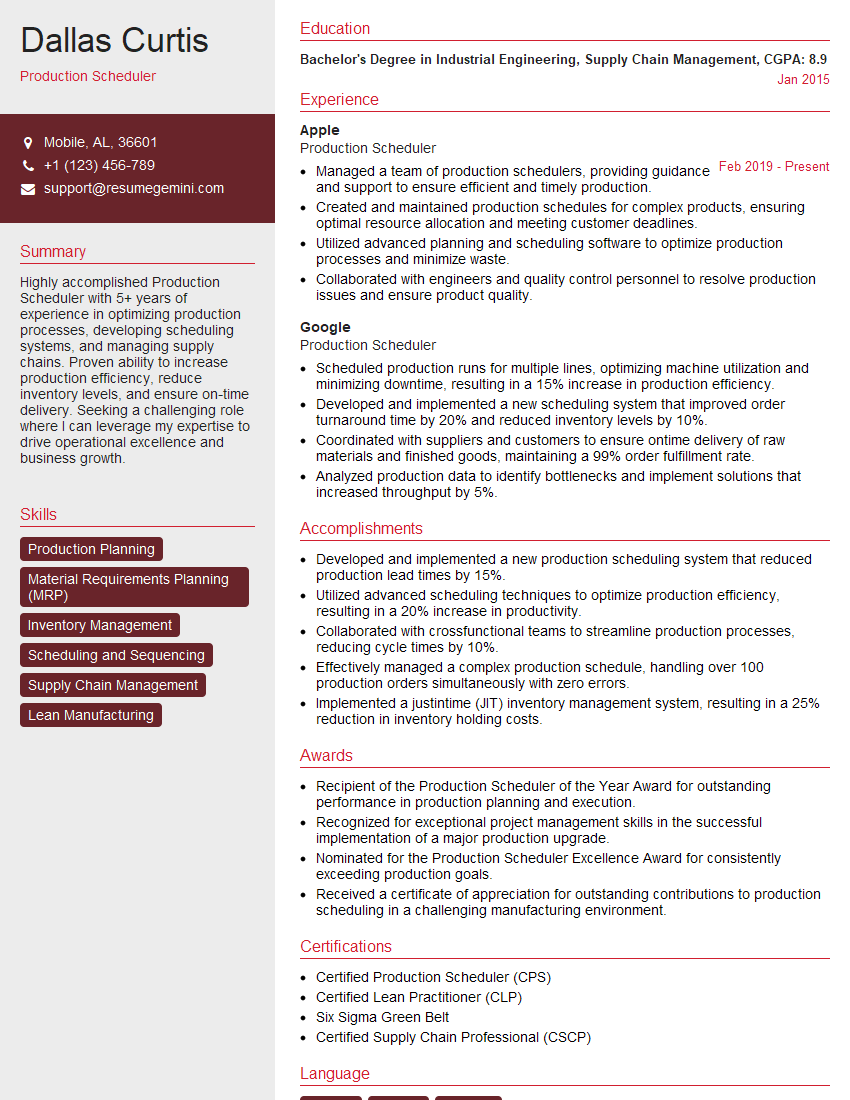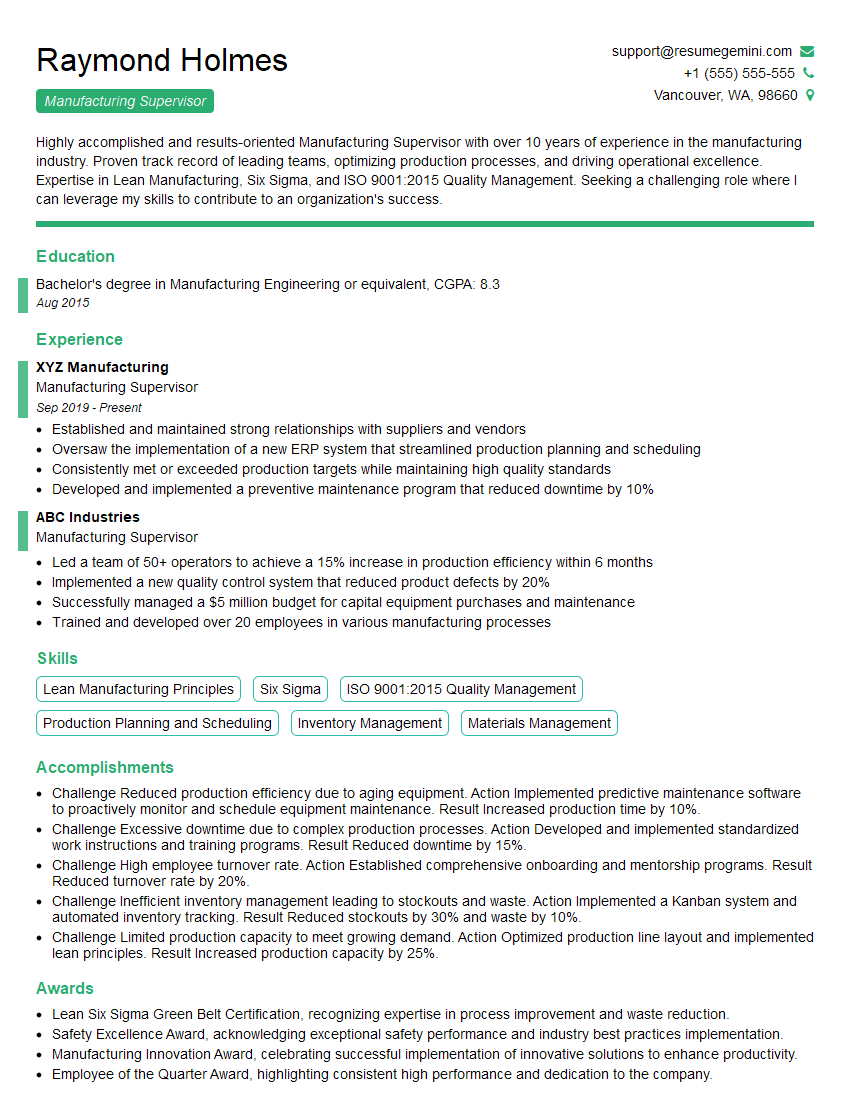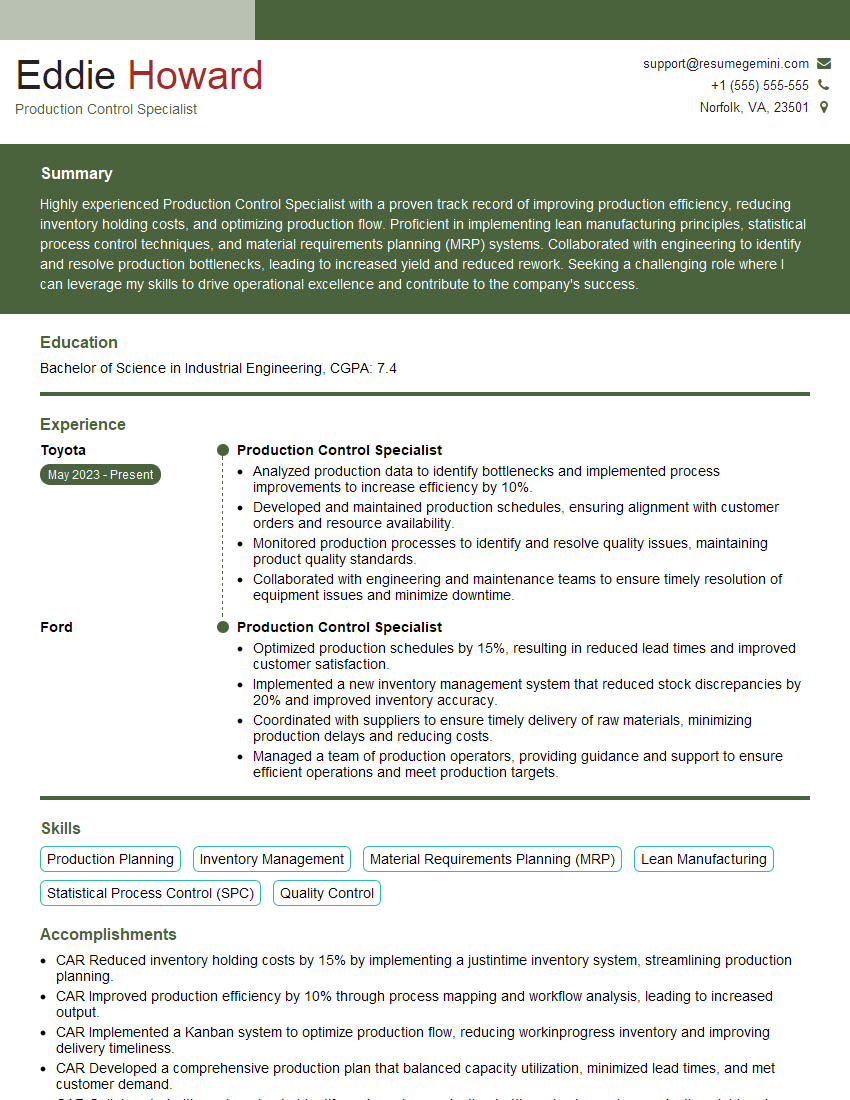Unlock your full potential by mastering the most common Scheduling and coordinating production runs interview questions. This blog offers a deep dive into the critical topics, ensuring you’re not only prepared to answer but to excel. With these insights, you’ll approach your interview with clarity and confidence.
Questions Asked in Scheduling and coordinating production runs Interview
Q 1. Explain your experience with different scheduling methodologies (e.g., Kanban, Lean, MRP).
My experience encompasses a variety of scheduling methodologies, each with its strengths and weaknesses depending on the production environment.
- Kanban: I’ve used Kanban successfully in environments requiring flexibility and rapid response to changing demands. Imagine a visual board tracking tasks (cards) moving through different stages of production. This allows for quick identification of bottlenecks and prioritization of high-value items. For example, in a software development setting, Kanban helped us quickly adapt to changing client requirements. We visually tracked bug fixes, feature implementations, and testing phases, allowing for efficient resource allocation and fast iterations.
- Lean Manufacturing: Lean principles, focused on eliminating waste and maximizing value, have been integral to my approach. This involves identifying and removing non-value-added activities, optimizing workflows, and implementing continuous improvement processes like Kaizen. In a previous role, implementing a lean system reduced production lead times by 20% by streamlining material handling and optimizing machine setups.
- Material Requirements Planning (MRP): MRP is a powerful tool for managing dependent demand, particularly in environments with complex bill of materials (BOMs). I’ve utilized MRP software to accurately forecast demand, schedule production runs, and manage inventory levels effectively. This proved crucial in a project involving multiple product variations where precise scheduling was essential to avoid stockouts and minimize production delays.
Choosing the right methodology depends on factors like product complexity, order variability, and the overall production environment. Often, a hybrid approach combining elements of different methodologies provides the best results.
Q 2. How do you prioritize production tasks when facing competing deadlines?
Prioritizing tasks with competing deadlines requires a structured approach. I typically use a combination of methods, including:
- Critical Path Method (CPM): This involves identifying the sequence of tasks that directly impacts the project completion time. Tasks on the critical path are given highest priority.
- Weighted Scoring System: I assign weights to different criteria like urgency, impact, and resource requirements. Tasks are then ranked based on their total weighted score. For example, a high-priority order with a tight deadline might receive higher weights than a less urgent order, even if the latter is larger in volume.
- Negotiation and Communication: Open communication with stakeholders is crucial. Sometimes, adjusting deadlines or scope becomes necessary to ensure efficient resource allocation. This might involve explaining trade-offs and getting buy-in from all parties involved.
Transparency is key. Regularly updating stakeholders on progress and potential roadblocks ensures everyone is aligned and allows for proactive adjustments to the schedule.
Q 3. Describe your process for resolving production bottlenecks.
Resolving production bottlenecks requires a systematic approach. My process usually involves:
- Identification: Use real-time monitoring systems and data analysis to pinpoint the bottleneck. This could involve examining machine utilization rates, material flow, or worker productivity.
- Analysis: Once identified, analyze the root cause. Is it due to insufficient capacity, machine downtime, material shortages, or process inefficiencies?
- Solutions: Develop and implement solutions based on the root cause. This might involve adding extra resources, improving machine maintenance procedures, streamlining processes, or adjusting the production schedule.
- Monitoring: Continuously monitor the bottleneck after implementing solutions to ensure its effectiveness. Regularly review data to ensure the problem remains resolved.
For example, if a bottleneck is caused by a specific machine’s slow processing speed, we might consider upgrading the machine, optimizing its settings, or redistributing the workload across multiple machines.
Q 4. How do you handle unexpected equipment downtime or material shortages?
Unexpected events like equipment downtime and material shortages require quick thinking and proactive mitigation strategies.
- Contingency Planning: Having backup plans for critical equipment and materials is essential. This could involve maintaining spare parts, sourcing materials from alternate suppliers, or having flexible production schedules that allow for re-allocation of resources.
- Root Cause Analysis: Investigate the reason for the downtime or shortage to prevent recurrence. This involves analyzing maintenance records, supplier performance, and internal processes.
- Communication and Collaboration: Immediately inform relevant stakeholders—maintenance teams, procurement, and sales—to coordinate efforts. This includes potentially renegotiating delivery dates with customers or finding alternative solutions.
- Prioritization: Reprioritize production tasks based on the impact of the disruption. Focus on fulfilling critical orders first.
For instance, if a key machine breaks down, we’d activate our backup plan – using a less efficient but available machine, while simultaneously expediting repairs on the primary machine. Open communication with clients ensures they’re informed and any necessary adjustments are made transparently.
Q 5. What metrics do you use to monitor production efficiency and schedule adherence?
Monitoring production efficiency and schedule adherence requires a set of key performance indicators (KPIs). I regularly track:
- On-Time Delivery Rate (OTDR): The percentage of orders delivered on or before the scheduled date.
- Production Lead Time: The time taken to complete a production run from start to finish.
- Overall Equipment Effectiveness (OEE): A measure of how effectively equipment is used, considering availability, performance, and quality.
- Inventory Turnover Rate: How quickly inventory is sold or used.
- Production Yield: The ratio of good units produced to total units processed.
- Schedule Adherence: Percentage of tasks completed as per the planned schedule.
These metrics, combined with regular production reports and data analysis, allow for identification of areas for improvement and provide insights into overall production efficiency. For example, a consistently low OEE might indicate the need for improved maintenance procedures or equipment upgrades.
Q 6. Explain your experience with production planning software (mention specific software if possible).
I have extensive experience with various production planning software packages. My experience includes using:
- SAP ERP: This comprehensive system offers robust production planning and scheduling capabilities, including MRP, capacity planning, and shop floor control. I’ve used SAP to manage complex production schedules and optimize resource allocation in large-scale manufacturing environments.
- Oracle NetSuite: This cloud-based solution provides effective tools for managing inventory, production planning, and order fulfillment. I’ve used NetSuite to streamline production processes and improve supply chain visibility in smaller to medium-sized businesses.
- Microsoft Dynamics 365: I’ve worked with Dynamics 365 for supply chain management, utilizing its features for production scheduling, forecasting, and warehouse management. Its strong integration with other Microsoft products improves data flow and collaboration.
The choice of software depends on the size and complexity of the organization and its specific needs. However, the core principles of effective production planning and scheduling remain consistent across different platforms.
Q 7. How do you collaborate with other departments (e.g., procurement, sales) to optimize production schedules?
Collaboration with other departments is crucial for optimizing production schedules. I actively engage with:
- Procurement: Close coordination with procurement ensures timely material availability. This includes sharing production schedules, forecasting demand, and collaborating on supplier selection to ensure reliable sourcing.
- Sales: Working closely with sales helps align production with customer demand. This involves understanding order forecasts, prioritizing urgent orders, and managing customer expectations regarding delivery dates.
- Quality Control: Regular communication with quality control ensures that defects are minimized and production quality meets standards. This allows for efficient identification and resolution of quality issues to avoid production delays and waste.
- Maintenance: Collaboration with maintenance helps minimize equipment downtime. This includes scheduled maintenance, proactive repairs, and effective communication regarding potential disruptions.
Effective communication and shared data through systems like ERP or collaborative platforms are key to ensuring seamless integration and optimized production schedules.
Q 8. Describe a time you had to make a critical scheduling decision under pressure.
One time, we faced a critical situation where a major client needed an urgent order – 10,000 units of our flagship product – within a drastically shortened timeframe. This was just days before our existing production line was scheduled for a planned maintenance shutdown. The pressure was immense, as missing this deadline would significantly impact our reputation and profitability.
My approach involved immediately convening a crisis meeting with the production, engineering, and logistics teams. We explored several options: pushing back the maintenance, working overtime, and potentially subcontracting part of the order. After analyzing the costs, risks, and production capacity of each solution, we opted for a combined strategy. We shifted a smaller portion of the order to an off-peak production line, and the remaining units were produced during overtime shifts, strategically scheduling around the essential maintenance tasks. This required meticulous coordination and close monitoring of progress, including daily progress reports and adjustments to the schedule based on real-time data. Successfully delivering the order on time not only reinforced our commitment to our clients but also demonstrated our team’s adaptability and problem-solving skills under high-pressure circumstances.
Q 9. How do you handle conflicting priorities between different production lines or projects?
Conflicting priorities are a common challenge in production scheduling. Think of it like a juggler – you have multiple balls in the air, and each requires attention. My approach uses a prioritization matrix based on factors like urgency, strategic importance, and potential impact on other projects.
- Urgency: How soon does the project need to be completed? Critical deadlines always take precedence.
- Strategic Importance: Does this project align with our overall business goals? High-impact projects are prioritized over smaller ones.
- Impact on Other Projects: Will delaying one project severely impact others? This necessitates careful consideration of dependencies.
I utilize project management software to visualize these priorities, making it easier to identify and resolve conflicts. For example, if two high-priority projects require the same equipment, I might negotiate with the stakeholders to adjust deadlines slightly, stagger the production runs, or explore alternative resource allocation. Transparency and open communication with all relevant parties are key to finding mutually acceptable solutions. Sometimes, difficult decisions need to be made; perhaps one project with a slightly less critical deadline will need to be pushed back to accommodate a higher priority.
Q 10. What techniques do you use to forecast demand and adjust production schedules accordingly?
Accurate demand forecasting is crucial for efficient production scheduling. I combine several techniques to achieve this:
- Historical Data Analysis: Analyzing past sales data, identifying trends and seasonality patterns.
- Market Research: Staying abreast of market trends, competitor analysis, and economic indicators.
- Sales Forecasts: Collaborating with the sales team to obtain their sales projections.
- Statistical Modeling: Using time series analysis and other statistical methods to predict future demand with a reasonable degree of accuracy.
These forecasts are then integrated into our production planning system. For instance, if a seasonal surge is predicted, we might ramp up production capacity in advance, adjusting our resource allocation accordingly. Regular review and adjustment of the forecasts are critical, as unforeseen events can impact demand. We use control charts to monitor deviations from the forecast and promptly make adjustments to the production schedule to mitigate potential issues.
Q 11. How do you ensure accurate inventory tracking and management within the production schedule?
Accurate inventory management is the backbone of efficient production. We use a real-time inventory tracking system integrated with our production scheduling software. This system utilizes barcode scanners and RFID technology to automatically update inventory levels as materials are used or finished goods are produced.
The system provides alerts for low stock levels, allowing us to proactively order replenishments to avoid production delays. Regular reconciliation between physical inventory counts and the system records helps identify and correct any discrepancies. This ensures we have the necessary materials available when and where they are needed, minimizing downtime and preventing costly stockouts. We employ the principles of just-in-time (JIT) inventory management where possible, minimizing storage costs and reducing the risk of obsolescence.
Q 12. Describe your experience with capacity planning and resource allocation.
Capacity planning and resource allocation are crucial for optimizing production efficiency. This involves analyzing available resources – equipment, personnel, and materials – and matching them with production demands.
I use several tools and techniques, including:
- Capacity Modeling: Creating models to simulate various scenarios and identify potential bottlenecks.
- Resource Leveling: Distributing workload evenly among resources to avoid overloading or underutilizing them.
- Critical Path Method (CPM): Identifying the critical path in a project schedule, helping prioritize tasks and allocate resources efficiently.
For instance, if we identify a bottleneck in a particular machine, we might explore options like investing in additional equipment, improving machine maintenance, or rescheduling production to balance the workload. Regular monitoring of resource utilization allows us to proactively address potential issues and make adjustments to our plans, ensuring optimal capacity utilization.
Q 13. How do you incorporate safety regulations and procedures into production scheduling?
Safety is paramount. We integrate safety regulations and procedures into every aspect of production scheduling. This is not just a checklist; it’s a core principle.
We achieve this through:
- Scheduled Safety Training: Regular training for all personnel on safe work practices, the use of equipment, and emergency procedures.
- Safety Audits and Inspections: Routine audits and inspections to identify and mitigate potential hazards.
- Risk Assessments: Conducting risk assessments for all production processes and incorporating safety measures into the schedule.
- Scheduled Maintenance: Regular maintenance of equipment to prevent accidents and ensure safety.
Scheduling downtime for safety inspections and maintenance is just as important as scheduling production runs. We consider safety a non-negotiable part of our production planning and treat it with the same level of priority as other operational goals.
Q 14. What is your approach to optimizing production lead times?
Optimizing production lead times is vital for competitiveness. Reducing lead time means faster delivery, improved customer satisfaction, and reduced inventory holding costs.
My approach focuses on several key areas:
- Process Optimization: Identifying and eliminating bottlenecks in the production process. This often involves streamlining workflows, improving material handling, and implementing lean manufacturing principles.
- Inventory Management: Ensuring the timely availability of materials and components using just-in-time inventory strategies.
- Technology Integration: Utilizing advanced technologies such as automated systems and real-time tracking to improve efficiency and visibility.
- Collaboration and Communication: Effective communication between different departments and stakeholders to improve coordination and minimize delays.
For example, we might use value stream mapping to identify non-value-added activities and eliminate them, leading to significant reductions in lead times. Continuous improvement initiatives, such as Kaizen events, are also vital in our ongoing pursuit of lead time reduction.
Q 15. How do you measure the success of your production scheduling efforts?
Measuring the success of production scheduling isn’t solely about meeting deadlines; it’s about optimizing the entire process. I use a multifaceted approach, tracking key performance indicators (KPIs) like:
- On-time delivery rate: This measures the percentage of orders shipped on or before the scheduled date. A high percentage indicates efficient scheduling and execution.
- Inventory turnover rate: This reflects how efficiently we manage inventory. A healthy turnover minimizes storage costs and reduces the risk of obsolescence.
- Production lead time: This is the time it takes to complete a product from raw materials to finished goods. Reducing lead time means faster delivery and increased responsiveness to market demands.
- Overall equipment effectiveness (OEE): This KPI combines availability, performance, and quality rates to reflect how effectively equipment is used. A high OEE suggests optimized scheduling that minimizes downtime and maximizes output.
- Customer satisfaction: Ultimately, successful scheduling leads to happy customers. Feedback surveys and reviews provide valuable insights into the impact of our scheduling on customer experience.
For instance, in my previous role, we implemented a new scheduling software that improved our on-time delivery rate by 15% within six months, directly impacting customer satisfaction scores.
Career Expert Tips:
- Ace those interviews! Prepare effectively by reviewing the Top 50 Most Common Interview Questions on ResumeGemini.
- Navigate your job search with confidence! Explore a wide range of Career Tips on ResumeGemini. Learn about common challenges and recommendations to overcome them.
- Craft the perfect resume! Master the Art of Resume Writing with ResumeGemini’s guide. Showcase your unique qualifications and achievements effectively.
- Don’t miss out on holiday savings! Build your dream resume with ResumeGemini’s ATS optimized templates.
Q 16. Explain your understanding of critical path analysis.
Critical Path Analysis (CPA) is a project management technique used to identify the longest sequence of dependent tasks in a project. This sequence, the critical path, determines the shortest possible duration to complete the entire project. Any delay on tasks within the critical path directly impacts the overall project completion time.
To illustrate, imagine assembling a car. The engine installation might be on the critical path because many subsequent tasks, like attaching the transmission and wiring the electronics, depend on it. If the engine installation is delayed, the entire car assembly is delayed.
In production scheduling, CPA helps identify bottlenecks and critical resources. By focusing on optimizing tasks along the critical path, we can minimize production time and improve efficiency. We use software tools that automatically calculate the critical path based on task dependencies and durations. This allows us to proactively address potential delays and allocate resources effectively.
Q 17. How do you communicate production schedule changes to relevant teams and stakeholders?
Communicating schedule changes is crucial for avoiding chaos and maintaining productivity. My approach involves a multi-channel strategy:
- Formal notification: Email or a company-wide messaging system is used for official announcements, ensuring everyone receives the updated schedule.
- Visual dashboards: Real-time dashboards displaying the updated schedule are accessible to all relevant teams. This provides transparency and immediate visibility into any changes.
- Team meetings: Regular meetings provide opportunities for clarification, addressing concerns, and ensuring buy-in from team members. These meetings also allow for collaborative problem-solving related to schedule changes.
- One-on-one communication: For critical or complex changes, direct communication with individuals or teams most affected is essential. This ensures personalized support and addresses specific challenges.
For example, when a major equipment malfunction caused a delay, we immediately updated the dashboard, sent a formal email, and held a team meeting to explain the situation, re-allocate tasks, and reassure everyone. Transparency was key in maintaining morale and productivity.
Q 18. What strategies do you use to improve communication and collaboration within the production team?
Improving communication and collaboration within a production team requires a proactive and multi-pronged approach:
- Establish clear communication channels: Designate specific communication methods for different purposes (e.g., email for formal updates, instant messaging for quick questions, regular meetings for strategy discussions).
- Promote open communication: Create a culture where team members feel comfortable sharing ideas, concerns, and feedback without fear of retribution.
- Regular team meetings: Conduct regular meetings to discuss progress, address challenges, and foster team cohesion. These meetings should be productive and focused.
- Use collaborative tools: Implement software tools such as project management software or shared document platforms that facilitate collaboration and information sharing.
- Cross-training: Cross-training empowers team members to support each other, improving flexibility and reducing the impact of individual absences.
In one instance, implementing a project management platform and incorporating daily stand-up meetings significantly improved the team’s efficiency and reduced communication-related delays.
Q 19. Describe your experience with lean manufacturing principles and their impact on scheduling.
Lean manufacturing principles focus on eliminating waste and maximizing value in the production process. This directly impacts scheduling by promoting efficiency and responsiveness. Key lean principles relevant to scheduling include:
- Just-in-time (JIT) inventory: Scheduling production to meet demand precisely, minimizing inventory holding costs and reducing waste. This requires accurate demand forecasting and robust scheduling.
- Kaizen (continuous improvement): Continuously evaluating and improving the scheduling process to identify and eliminate bottlenecks and inefficiencies.
- 5S methodology (sort, set in order, shine, standardize, sustain): Organizing the workplace to streamline workflows and improve efficiency, directly impacting scheduling accuracy and predictability.
- Value stream mapping: Visualizing the entire production process to identify waste and opportunities for improvement in the scheduling process.
For example, implementing a JIT inventory system led to a significant reduction in warehousing costs and allowed for faster responses to changes in customer demand, optimizing the production schedule’s responsiveness.
Q 20. How do you balance production efficiency with quality control?
Balancing production efficiency and quality control is crucial for long-term success. It’s not a trade-off, but rather a synergy. Here’s how I approach this:
- Quality built-in: Integrate quality checks at various stages of the production process, rather than relying solely on end-of-line inspections. This prevents defective products from progressing further, saving time and resources.
- Preventive maintenance: Regular equipment maintenance minimizes downtime and prevents defects caused by malfunctioning machinery. This is incorporated into the schedule proactively.
- Employee empowerment: Empower employees to stop production if they identify a quality issue. This emphasizes quality over speed and prevents the propagation of defects.
- Data-driven decisions: Track quality metrics and use the data to identify areas for improvement in both production efficiency and quality control. This provides a continuous feedback loop for scheduling adjustments.
For example, implementing a system where operators could halt the production line if they detected a defect, although initially seeming to reduce throughput, significantly reduced rework and scrap, ultimately leading to greater efficiency.
Q 21. How familiar are you with different types of production scheduling software?
I have extensive experience with various production scheduling software, including:
- Enterprise Resource Planning (ERP) systems: Such as SAP, Oracle, and Microsoft Dynamics 365, offering integrated solutions for production planning, inventory management, and order fulfillment. These systems are especially useful for large-scale operations.
- Manufacturing Execution Systems (MES): Such as Rockwell Automation’s FactoryTalk MES, and Siemens Opcenter, providing real-time monitoring and control of the production floor, allowing for immediate adjustments to the schedule.
- Advanced Planning and Scheduling (APS) software: These specialized tools, like Preactor and Blue Hornet, offer advanced features like optimization algorithms and what-if scenario analysis, leading to more efficient schedules.
- Cloud-based scheduling solutions: Various cloud-based platforms offer scalable and accessible scheduling tools, suitable for businesses of all sizes.
My experience extends to implementing, configuring, and optimizing these systems, tailoring them to specific production needs and integrating them with other enterprise software. I am proficient in using their reporting and analytical features to continuously improve scheduling processes.
Q 22. Explain your experience with managing production schedules across multiple locations or shifts.
Managing production schedules across multiple locations and shifts requires a robust system that ensures seamless communication and coordination. I’ve successfully implemented and managed such systems using a combination of advanced scheduling software and clearly defined communication protocols. This involved not only scheduling production runs based on capacity, material availability, and demand forecasts from each location but also optimizing transportation logistics and resource allocation across sites. For example, in my previous role at Acme Manufacturing, we had three production facilities across two states. We utilized a centralized scheduling system which allowed us to prioritize urgent orders, efficiently allocate resources based on real-time data, and track progress in real-time. We used color-coded dashboards to highlight potential bottlenecks or delays across all locations and shifts, allowing for proactive intervention and minimizing disruption.
To ensure smooth transitions between shifts, we implemented detailed handover procedures, including comprehensive shift reports and a dedicated communication channel. This minimized delays and ensured consistency in production across all shifts. This structured approach was crucial to meeting our production targets and maintaining high levels of efficiency across geographically dispersed operations.
Q 23. How do you handle changes in customer demand or order priorities?
Handling changes in customer demand or order priorities requires flexibility and a proactive approach. My strategy involves utilizing a dynamic scheduling system that allows for real-time adjustments. This includes incorporating buffer time in the schedule to accommodate unexpected changes and employing a system of prioritized order fulfillment based on factors like due dates, contract terms, and customer importance. For example, if a rush order with a tight deadline comes in, I use the scheduling software to evaluate the impact on the existing schedule, identify available capacity, and reshuffle tasks to meet the new priority.
Communication is vital in this process. I actively keep customers informed of any potential delays or changes in the delivery schedule. Transparency builds trust and mitigates potential conflicts. Internally, I utilize daily stand-up meetings to communicate changes to the production team, ensuring everyone is aware of the updated schedule and their roles in executing it. This ensures that the team understands the priorities and can adapt quickly to the changes. We also use a Kanban board to visualize the workflow and track progress of each order.
Q 24. Describe a time you had to adapt your production schedule due to unforeseen circumstances.
During a major equipment malfunction at our primary manufacturing facility, we faced a significant challenge in maintaining our production schedule. The equipment failure resulted in a complete halt of one of our main production lines, impacting a large portion of our output. My immediate response was to activate our contingency plan which involved: 1) assessing the damage and the estimated repair time, 2) immediately notifying our customers about the potential delays, 3) reallocating the affected production tasks to our secondary facility, and 4) negotiating with suppliers to expedite the delivery of replacement parts.
To manage the workload at the secondary facility, we implemented overtime shifts and re-prioritized existing orders. Despite the unexpected disruption, we managed to minimize the overall impact on our customers by keeping them informed and proactively adjusting our schedule. This experience highlighted the importance of having well-defined contingency plans and strong relationships with suppliers and customers.
Q 25. What are your strategies for reducing production costs while maintaining schedule adherence?
Reducing production costs while maintaining schedule adherence requires a strategic approach that focuses on efficiency and optimization. My strategies involve:
- Lean Manufacturing Principles: Implementing lean manufacturing principles, such as eliminating waste, optimizing workflows, and improving efficiency across all processes. This could involve streamlining production processes, reducing material waste, and improving inventory management.
- Preventive Maintenance: Regular preventative maintenance on equipment reduces downtime and extends the lifespan of machinery, thereby reducing repair costs and improving overall efficiency.
- Inventory Optimization: Implementing robust inventory management systems to reduce storage costs and minimize the risk of stockouts or overstocking. This ensures that we have the right amount of materials at the right time, minimizing waste and storage costs.
- Negotiating with Suppliers: Negotiating favorable terms with suppliers to secure cost-effective materials and services.
- Process Automation: Automating repetitive tasks wherever feasible, which improves efficiency and reduces labor costs.
By strategically implementing these strategies, I’ve consistently helped companies improve their production efficiency and profitability without compromising the adherence to production schedules.
Q 26. How do you identify and address potential risks to the production schedule?
Identifying and addressing potential risks to the production schedule requires a proactive risk management approach. This involves a structured process of:
- Risk Identification: Identifying potential risks through regular reviews of the production schedule, considering factors such as equipment failures, material shortages, supply chain disruptions, and workforce availability.
- Risk Assessment: Assessing the likelihood and impact of each identified risk.
- Risk Mitigation: Developing and implementing mitigation strategies to reduce the likelihood or impact of each risk. This might involve creating contingency plans, establishing buffer times, or investing in redundant equipment.
- Monitoring and Review: Regularly monitoring the production schedule for any emerging risks and reviewing the effectiveness of the mitigation strategies.
Utilizing tools such as Gantt charts and risk registers helps visualize potential problems and facilitates proactive planning. For example, by anticipating potential supply chain disruptions due to seasonal fluctuations, we can proactively secure alternative sources of materials and build up inventory in advance, mitigating the risk of delays. Regular communication with all stakeholders is also critical in identifying and addressing these potential disruptions early on.
Q 27. What are your strengths and weaknesses in production scheduling?
My strengths in production scheduling lie in my analytical skills, my ability to think strategically, and my experience with various scheduling software and methodologies. I’m adept at optimizing complex schedules, anticipating potential bottlenecks, and developing effective contingency plans. I excel at communicating effectively with cross-functional teams and providing timely and accurate updates to stakeholders.
My area for improvement is delegation. While I’m proficient at managing large-scale projects, I sometimes find it challenging to fully delegate tasks, leading to an increased workload on my end. I am actively working on improving my delegation skills by developing trust in my team members and providing them with more autonomy. This will allow me to focus on higher-level strategic planning and decision-making.
Q 28. Where do you see yourself in 5 years regarding your career in production scheduling?
In five years, I see myself in a leadership role within a production scheduling department, mentoring and guiding a team to achieve even greater efficiency and effectiveness. I envision myself leading process improvement initiatives, leveraging advanced technologies like AI and machine learning to optimize scheduling processes and potentially expanding my expertise into areas like supply chain optimization and overall operations management. My goal is to be a key contributor to a company’s success by optimizing their production processes and maximizing their profitability. I aim to continue learning and developing my skills in this dynamic field, staying abreast of the latest advancements and best practices.
Key Topics to Learn for Scheduling and Coordinating Production Runs Interview
- Production Planning & Sequencing: Understanding different scheduling methodologies (e.g., FIFO, LIFO, priority scheduling) and their application in optimizing production flow. Practical application: Analyzing production orders and determining the most efficient sequence to minimize lead times and maximize resource utilization.
- Capacity Planning & Resource Allocation: Assessing available resources (machinery, personnel, materials) and aligning them with production demands. Practical application: Developing detailed production schedules that consider machine downtime, employee availability, and material lead times.
- Material Requirements Planning (MRP): Understanding the process of planning and procuring necessary materials to support the production schedule. Practical application: Working with procurement teams to ensure timely delivery of materials, preventing production delays due to shortages.
- Production Scheduling Software: Familiarity with common software used for scheduling and tracking production (e.g., ERP systems, specialized scheduling tools). Practical application: Demonstrating proficiency in using such software to create, manage, and analyze production schedules.
- Problem-Solving & Optimization: Identifying and resolving scheduling conflicts, bottlenecks, and inefficiencies. Practical application: Developing contingency plans to address unexpected delays or disruptions in the production process.
- Metrics and Reporting: Understanding key performance indicators (KPIs) related to production scheduling, such as on-time delivery, throughput, and efficiency. Practical application: Analyzing production data to identify areas for improvement and track progress towards goals.
- Communication & Collaboration: Effectively communicating schedules and updates to relevant stakeholders (e.g., production teams, management, clients). Practical application: Demonstrating strong teamwork skills and the ability to resolve conflicts effectively.
Next Steps
Mastering scheduling and coordinating production runs is crucial for career advancement in manufacturing and operations. It demonstrates your ability to manage complex processes, optimize resource allocation, and drive efficiency – highly valued skills in today’s competitive job market. To significantly boost your job prospects, create an ATS-friendly resume that highlights your relevant skills and experiences. ResumeGemini is a trusted resource for building professional resumes that stand out. Take advantage of their tools and resources, and view examples of resumes tailored to Scheduling and coordinating production runs to get started on your path to success!
Explore more articles
Users Rating of Our Blogs
Share Your Experience
We value your feedback! Please rate our content and share your thoughts (optional).
What Readers Say About Our Blog
This was kind of a unique content I found around the specialized skills. Very helpful questions and good detailed answers.
Very Helpful blog, thank you Interviewgemini team.
